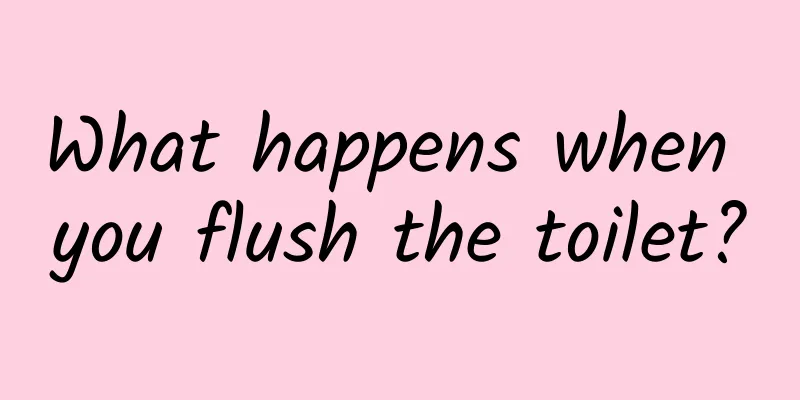What happens when you flush the toilet?

|
© The Independent Leviathan Press: The toilets we often use are generally divided into two types: direct flush and siphon. In theory, when the toilet is flushed, the water will generate a vortex under the force of the flush and form an aerosol (a general term for solid particles or liquid droplets suspended in the air). These aerosols will rise into the air, float in the air, or attach to objects such as walls, toothbrushes, and towels. However, when flushing a siphon toilet commonly used in households, due to the small amount of water and low pressure, the number of bacteria brought up by the cyclone is limited, so there is no need to worry about it. On the contrary, for a direct flush toilet, it is best to cover the toilet lid after use and then flush. In the dark days early in the coronavirus pandemic, when we knew next to nothing about the virus and feared next to everything, there was a time when people became very, very worried about what was happening in the bathroom. More specifically, they worried that the “cloud of particles” that was ejected into the air when the toilet was flushed, known in the scientific literature as the “toilet plume,” might be an important vector of transmission of the coronavirus. © Good Housekeeping In June 2020, the New York Times warned[1] that because the coronavirus is also present in human excrement, “flushing the toilet could spread aerosolized coronavirus everywhere.” In the years since, scientists or public health experts have occasionally issued public service announcements about the issue, each time reigniting fears about feces. In retrospect, much of what we thought we knew early in the pandemic was wrong. Spraying groceries with Lysol proved useless. Masks also proved useful. Washing hands, while important, was not as important as cracked up to be, and herd immunity turned out to be a mirage.[2] As the country moves into post-pandemic life, it’s worth asking as we assess the past three years: What is going on with toilet plumes? In short, our fears were unfounded, but they weren't entirely exaggerated, either. Scientists have studied toilet plumes for decades. They've found that the size of the plume depends on the type of toilet and the flushing mechanism. The energy of the flush also plays a role: The harder the flush, the bigger the plume. Putting the toilet lid on (if it has one) helps a lot, but even that doesn't completely eliminate the toilet plume—particles can still escape through the gap between the toilet seat and lid. Whatever the differences in detail between studies, before the pandemic, the main conclusions from years of research were consistent and gross: In a 2013 review article titled “Lifting the Lid on Toilet Plume Aerosol,”[3] scientists from the Centers for Disease Control and Prevention (CDC) and the University of Oklahoma School of Public Health wrote that “flushing toilets generates large amounts of toilet plume aerosols that can carry microorganisms at least as large as bacteria… These bioaerosols can remain airborne for long periods of time and travel on air currents.” In other words, when you flush the toilet, a disturbing amount of its contents goes up into the air rather than down the pipe. Knowing about it is one thing; seeing it is another. Traditionally, scientists have measured toilet plumes using particle counters or “a computational model of an idealized toilet” (at least one study has used the latter). But in a new study published last month[4], researchers at the University of Colorado at Boulder went a step further, using bright green lasers to make visible what is (thankfully) normally invisible. John Crimaldi, a professor of engineering and co-author of the study, has spent 25 years studying how to illuminate invisible phenomena with lasers. Toilet plume captured at 2.8, 4.4, and 6.4 seconds into the flush. © John Crimaldi et al. / University of Colorado Boulder He told me that when he and his colleagues began the experiment, they were sure they would see something. Even so, the results were “completely beyond their expectations.” The plume was larger, faster, and more powerful than they had expected—“ like an eruption, ” Crimaldi said, or, as he and his colleagues put it in their paper, “a powerful, chaotic jet.” © John Crimaldi et al. / University of Colorado Boulder Within eight seconds of flushing the toilet, the resulting aerosol cloud will be nearly five feet** (1.52 meters) away from the toilet seat —that’s more than six feet (1.83 meters) off the ground ****. In other words: It’s going straight into your face.** A map of the rapid growth of the aerosol plume over time and space after a toilet flush. © John Crimaldi et al. / University of Colorado Boulder After the initial eruption, the plume continues to rise until it hits the ceiling, where it then drifts outward. When it hits a wall, it flows along it. Pretty soon, it fills the room. And once it fills the room, it stays there for a while. "You can imagine in your mind walking into a public restroom at an airport and there are 20 stalls, and every stall is flushed every few minutes," Crimaldi said. It's not a pleasant image. So the question isn’t so much whether the toilet plume phenomenon happens (like it or not, it obviously does), but whether it poses a risk of spreading the coronavirus or something else bad. But we don’t know that part very well. The 2013 review considered studies of the original SARS virus “among the most convincing indicators that toilet plumes could contribute to airborne disease.” (The authors also noted that, although SARS “is not yet a common disease, it has demonstrated its potential for explosive spread and high mortality.”) In a study of the 2003 SARS outbreak at the Amoy Gardens apartment complex in Hong Kong, for example, the authors explicitly discussed transmission of the disease through toilet plumes. But Mark Sobsey, an environmental microbiologist at the University of North Carolina at Chapel Hill, told me that the research was far from definitive. The researchers did not rule out other modes of transmission, nor did they try to culture live virus from feces—a much more reliable indicator of infectivity than simply detecting the virus. Beyond that, Sobhsi says there is little evidence that toilet plumes can spread SARS or COVID-19. In comments published in December 2021[5], Sobhsi himself said there is “no documented evidence” that the virus can be spread through feces. At least, that seems to be consistent with our experience during the three-year pandemic we have just survived. While we can’t easily prove that bathrooms didn’t play a major role in spreading the coronavirus, we haven’t found any clear evidence that they did, and, in any case, the coronavirus has found many other terrible ways to spread. But while toilet plume doesn’t appear to be a vector for the coronavirus, that doesn’t mean you can forget about it. Sobhi told me that gastrointestinal viruses like norovirus pose a greater risk of transmission through toilet plume because they are literally transmitted through feces. The only real solution is structural. Improved ventilation can prevent aerosolized fecal matter from accumulating in the air, while germicidal lighting, although still under development, could likely disinfect any residue.[6] Neither of these approaches, however, will stop the plume in the first place. To do that, you’d need to modify the toilet itself: You could change the geometry of the seat, the way water flows in and out, or any number of other variables to make the flush smoother and more controlled. And, you know, toilet manufacturers could just stop making lidless toilets. © Landmark Home Warranty But none of this will help the next time you're staring into the empty mouth of a toilet. Crimaldi recommends that people wear masks in public restrooms, which not only block the plume created by your own flush, but also the plume left by the person who used the bathroom before you, and the plume left by the person who used the bathroom before them, and so on. You don’t need to have a deep emotional connection to wearing a mask as a public health intervention, you just need to consider wearing it for a few minutes to avoid actually breathing in feces. Sobhi offered another unconventional bathroom hygiene tip, one that he acknowledged will only offer you limited protection: If you find that your public restroom toilet doesn’t have a lid, he said you might consider washing your hands before flushing, then “hold your breath, flush the toilet, and run.” References: [1]www.nytimes.com/2020/06/16/health/coronavirus-toilets-flushing.html [2]www.theatlantic.com/health/archive/2022/10/covid-pandemic-airborne-virus-transmission-hand-washing/671831/ [3]www.ncbi.nlm.nih.gov/pmc/articles/PMC4692156/ [4]www.nature.com/articles/s41598-022-24686-5 [5]iwaponline.com/jwh/article/20/1/126/85839/Absence-of-virological-and-epidemiological [6]www.nature.com/articles/s41598-022-24686-5 By Jacob Stern Translated by Kushan Proofreading/Lean Bamboo and Bean Curd Original article/www.theatlantic.com/health/archive/2023/01/covid-virus-spread-toilets-public-bathrooms/672846/ This article is based on the Creative Commons License (BY-NC) and is published by Kushan on Leviathan The article only reflects the author's views and does not necessarily represent the position of Leviathan |
Recommend
Refined operation strategy for users with repurchase rate of over 95%
What I want to share today is the refined operati...
Inventory of 6 skills and tools for short video operations!
"With the continuous changes in the mechanis...
[Case] How did her community achieve 40 million users in a year?
In the past six months, many mobile community app...
Who "killed" Luo Yonghao?
A friend said he wanted to buy a ticket to attend...
How to do viral marketing well? 3 types and 4 elements you must know
Viral marketing is a very effective way to achiev...
WeChat's latest features at a glance! In addition to dark mode, voice-to-text is also more convenient
[[319532]] The new iOS version of WeChat has more...
Baidu SEM upgrade: conversion URL analysis, cases + steps + precautions! Receive~
Important notice: Baidu upgrades conversion URL p...
Wang Tianqing: Analysis of Madai Financial Management Big Data Platform and Financial Risk Control Practice Cases
At the WOT "Internet +" era big data te...
Top 10 Essential Tools for WeChat Official Account Operations (Just Needed)
Recent articles are mainly about new media tools ...
Why is geological exploration not optional?
According to the search and rescue command center...
Why is it that only LeTV Super TV won the IFA Gold Award?
On September 2, Berlin, Germany, IFA, Europe'...
How much does it cost to develop a mini program for Hegang Dance School? Hegang Dance School Mini Program Development Price Inquiry
Mini programs provide convenience for publicity a...
9 ways to attract traffic for offline promotion!
How can offline brand store merchants build a tra...
Content Operation: The content strategy that made Xiaohongshu so popular!
Tencent took the lead in the last round of financ...









